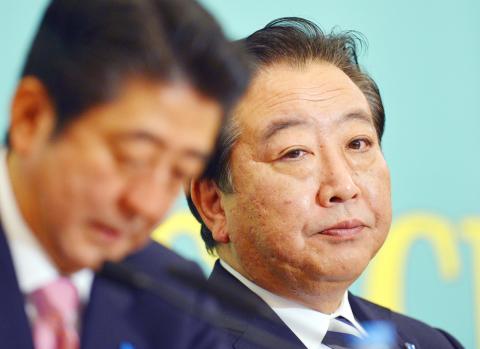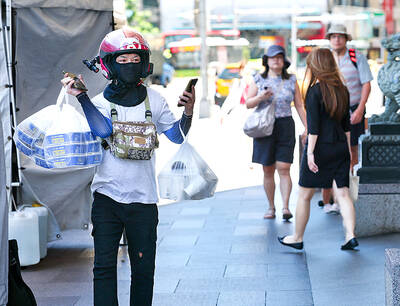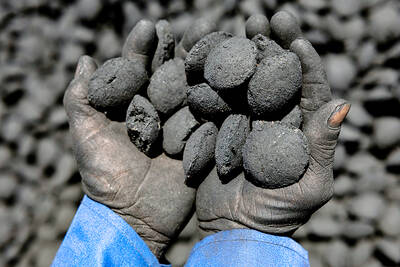Tokyo yesterday approved US$10.7 billion in fresh spending to help boost Japan’s limp economy, just weeks before an election the ruling party is expected to lose.
The ¥880 billion (US$10.7 billion) in spending was more than double a package announced in October as the country gets set for polls that are expected to usher in Japan’s seventh prime minister in six years.
However, the move, which came as official data showed Japan posted a surprise uplift in factory production in October, threatened to trigger vote-buying criticism from opposition lawmakers.

Photo: EPA
The spending will focus on boosting growth in a range of sectors, including healthcare and agriculture, as well as on public works projects following last year’s earthquake and tsunami disaster.
Opinion polls suggest Prime Minister Yoshihiko Noda and his Democratic Party of Japan (DPJ) will be defeated by the country’s main opposition leader Shinzo Abe, who heads the Liberal Democratic Party (LDP).
Abe has vowed to spend heavily on public works and pressure the Bank of Japan into launching aggressive monetary easing measures to boost growth if his party wins the Dec. 16 vote.
The central bank has unveiled two policy easing measures in recent months as its counterparts in the US and Europe launched huge moves to counter slowing growth.
Japan’s economy contracted in the July to September quarter, nudging it toward recession and dousing hopes that the nation had cemented a recovery after last year’s twin disasters, which triggered the worst atomic crisis in a generation.
Masamichi Adachi, a senior economist at JPMorgan Securities, questioned the effectiveness of the latest government stimulus measures.
“While [the package] wouldn’t be a poison, it wouldn’t be a medicine either,” Adachi told reporters.
A glimmer of hope emerged yesterday as official data showed Japan’s factory output rose 1.8 percent in October, the first rise in four months and beating market expectations of a 2.2 percent drop.
Separate figures showed the jobless rate held steady while household spending for the month was better than expected, suggesting a possible improvement in consumer confidence.
The unexpected output jump — and a producers’ survey that forecast a 7.5 output rise this month after a small decline for last month — gave the Tokyo stock market a small boost with the benchmark Nikkei 225 index adding 0.48 percent by the close.
However, the economy ministry doused hopes that the latest data was something to cheer about, saying in a statement that output was on a “downward trend.”
Credit Agricole economist Kazuhiko Ogata cautioned against optimism, saying a sustained recovery would depend on stronger overseas demand for Japanese exports, while producers will have to bring down their built-up inventory.
“A bottom-out of production would be confirmed only after the turn of the year at the earliest,” Ogata said.
Chris Tedder, research analyst at Forex.com in Sydney, said the new figures quelled “some concern of a prolonged slowdown in the world’s third-largest economy.”
However, “overall, the data isn’t enough to turn us away from predicting a recession in Japan this quarter,” he said.
As weak European markets dent demand for Japanese exports, a territorial row over islands in the East China Sea claimed by Tokyo, Taipei and Beijing has also affected the trade balance owing to a consumer boycott of Japanese brands.
Japan’s top three automakers — Toyota, Nissan and Honda — all reported that the row with China has affected sales and profits, with October data on Thursday showing a marked drop output in China, the world’s biggest vehicle market.

Greek tourism student Katerina quit within a month of starting work at a five-star hotel in Halkidiki, one of the country’s top destinations, because she said conditions were so dire. Beyond the bad pay, the 22-year-old said that her working and living conditions were “miserable and unacceptable.” Millions holiday in Greece every year, but its vital tourism industry is finding it harder and harder to recruit Greeks to look after them. “I was asked to work in any department of the hotel where there was a need, from service to cleaning,” said Katerina, a tourism and marketing student, who would

i Gasoline and diesel prices at fuel stations are this week to rise NT$0.1 per liter, as tensions in the Middle East pushed crude oil prices higher last week, CPC Corp, Taiwan (台灣中油) and Formosa Petrochemical Corp (台塑石化) said yesterday. International crude oil prices last week rose for the third consecutive week due to an escalating conflict between Israel and Iran, as the market is concerned that the situation in the Middle East might affect crude oil supply, CPC and Formosa said in separate statements. Front-month Brent crude oil futures — the international oil benchmark — rose 3.75 percent to settle at US$77.01

RECORD LOW: Global firms’ increased inventories, tariff disputes not yet impacting Taiwan and new graduates not yet entering the market contributed to the decrease Taiwan’s unemployment rate last month dropped to 3.3 percent, the lowest for the month in 25 years, as strong exports and resilient domestic demand boosted hiring across various sectors, the Directorate-General of Budget, Accounting and Statistics (DGBAS) said yesterday. After seasonal adjustments, the jobless rate eased to 3.34 percent, the best performance in 24 years, suggesting a stable labor market, although a mild increase is expected with the graduation season from this month through August, the statistics agency said. “Potential shocks from tariff disputes between the US and China have yet to affect Taiwan’s job market,” Census Department Deputy Director Tan Wen-ling

As they zigzagged from one machine to another in the searing African sun, the workers were covered in black soot. However, the charcoal they were making is known as “green,” and backers hope it can save impoverished Chad from rampant deforestation. Chad, a vast, landlocked country of 19 million people perched at the crossroads of north and central Africa, is steadily turning to desert. It has lost more than 90 percent of its forest cover since the 1970s, hit by climate change and overexploitation of trees for household uses such as cooking, officials say. “Green charcoal” aims to protect what